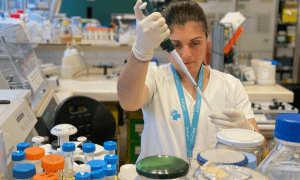An innovative cancer vaccination system reduces the progression of melanoma in preclinical studies

Based on a study by IrsiCaixa and BSC, researchers have developed a new algorithm to enhance precision in selecting molecules, called neoantigens, that induce effective immune responses against cancer
One characteristic of cancer cells is the presence of neoantigens, specific proteins not found in healthy cells of the body. For a long time, the scientific community has targeted these neoantigens as therapeutic targets for cancer. Neoantigens can activate the immune system, thereby assisting the human body in generating an immune response against tumor cells—a capability known as immunogenicity. However, not all neoantigens are equally immunogenic, and selecting the best candidates for developing therapies is not an easy task. A new study published in the Journal of Translational Medicine and conducted by the IrsiCaixa AIDS Research Institute –a centre jointly supported by the "la Caixa" Foundation and the Department of Health of the Generalitat de Catalunya– and the Barcelona Supercomputing Center – Centro Nacional de Supercomputación (BSC-CNS) has developed a computer algorithm optimized for selecting highly immunogenic neoantigens. The scientific team utilized this new algorithm in preclinical models of melanoma to design vaccines based on Virus-Like Particles (VLPs), and they observed a slower progression of tumour growth as well as improved survival.
"The advantage of using VLPs compared to other technologies is that in each particle, we can add around 15 different neoantigens, and each of them is repeated in approximately 2500 copies. This promotes the body's ability to generate a broad immune response against the tumour," comments Julià Blanco, co-leader of the study and IGTP researcher at IrsiCaixa.
Finding the most immunogenic neoantigens is key for cancer vaccines
The human body has the ability to detect the presence of foreign entities, whether they come from outside, such as viruses or bacteria, or from within, such as cancer cells. To do this, it uses molecules called MHC-I, which constantly display protein fragments to the T cells of the immune system. If the proteins presented by MHC-I belong to healthy cells of the body, everything remains normal. However, if they come from cancer cells, as is the case with neoantigens, T cells activate an immune response against them, generating an anti-tumor effect.
"When the body identifies a foreign molecule, our defences trigger all emergency alarms. The goal of our study is to find the most immunogenic neoantigen, that is, the one that triggers a more potent immune response", details Carmen Aguilar, co-leader of the study and senior researcher at IrsiCaixa. To achieve this, it is necessary to find neoantigens with a high affinity for MHC-I, whose structure allows binding with MHC-I, promoting T cell stimulation. This allows the neoantigen to easily bind to MHC-I, and T cells detect it to initiate a robust immune response.
"Current computer algorithms focus on experimental affinity databases, which are of very low precision. Faced with this, we considered developing a new algorithm: the Neoantigen Optimization AlgoritHm (NOAH)", explains Victor Guallar, co-leader of the study and researcher at BSC. "With NOAH, we have added an additional factor based on the structure of the MHC-neoantigen complex and the elemental factors that favor this interaction, resulting in a more careful prediction", he adds.
Slowing tumour growth and increased survival
Prediction tools enable the identification of molecules that activate the immune system. Once identified, it is necessary to find a way to administer them to patients. IrsiCaixa has a VLP-based vaccine platform, a technology patented by the same institution, initially developed to combat HIV, which has proven useful in cancer research. "These virus-like particles can be tailored to our needs and allow us to introduce different combinations of neoantigens, potentially leading to the personalization of these vaccines. This tailored modification allows us to broaden the scope and target different types of cancers with the same platform. In fact, currently, at IrsiCaixa, we are also working with other types of cancer, including triple-negative breast cancer, head and neck cancer, and pancreatic cancer," explains Núria de la Iglesia, principal investigator and head of cancer research at IrsiCaixa.
At the biosafety facilities of the Center for Comparative Medicine and Bioimaging (CMCiB) that the Germans Trias i Pujol Institute (IGTP) has at the Can Ruti Campus, the scientific team conducted preclinical experiments using these VLP-based vaccines, to which different neoantigens chosen by NOAH were added, resulting in neoVLPs. "The results we have obtained are promising, as we observed a deceleration of tumour growth, as well as an improvement in survival", adds Ana Barajas, co-author of the article and predoctoral researcher at IrsiCaixa at the time of the study. In fact, some of the vaccinated mice did not develop tumours, demonstrating that the immune response induced by VLPs may be protective. This protective effect could be enhanced by combination with other therapeutic strategies, such as immune checkpoint inhibitors.
Compared to other vaccine design technologies, VLPs offer several advantages: firstly, they are safe, as they cannot replicate in the body; secondly, they induce a rapid and potent immune response because of their size and structure similarity to viruses; and finally, in addition to the target antigens, VLPs can be loaded with immunomodulators, thus promoting the induction of a more effective immune response. "Considering all these advantages, along with the results obtained so far, we believe that personalized cancer immunotherapy could find a promising option for the future in VLP-based vaccination", concludes Jorge Carrillo, co-leader of the study and principal investigator at IrsiCaixa.